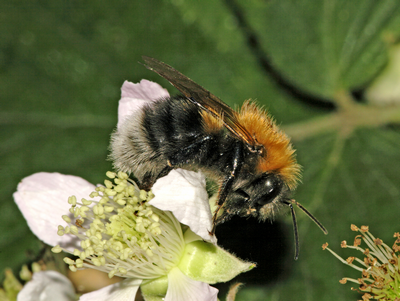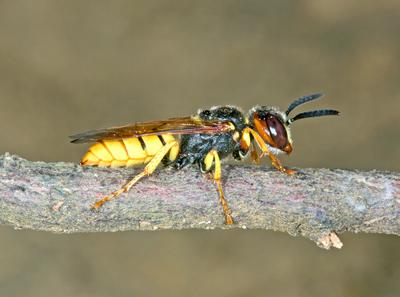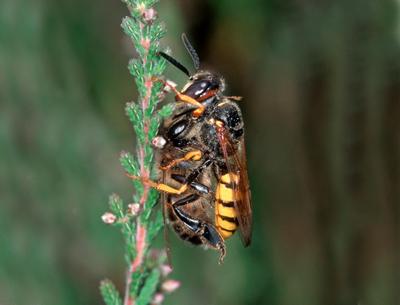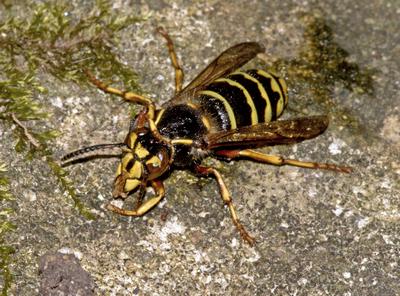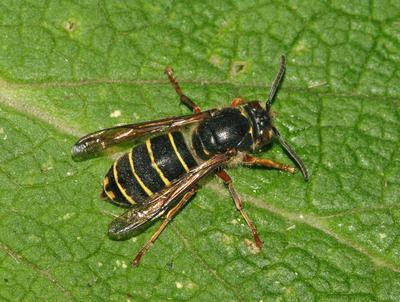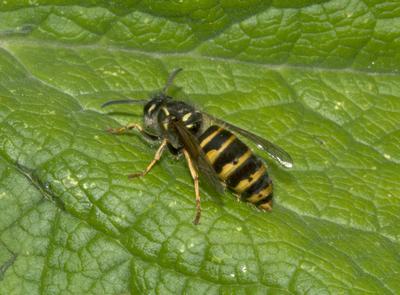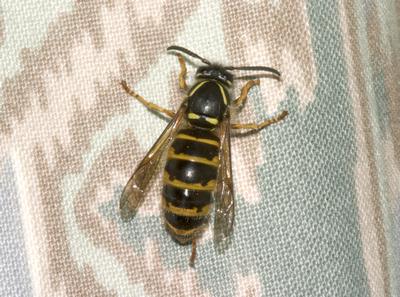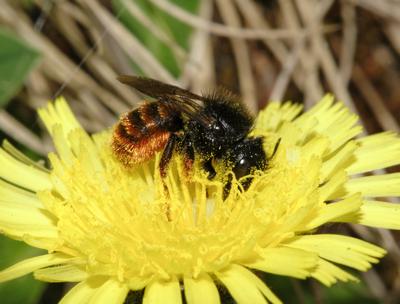Populations of many species are in a constant state of flux and it is often difficult to assign a cause to increases, decreases or complete changes of range, all of which may be short or long term phenomena. Very occasionally beneficial genetic mutations may allow a species to extend its range but the more usual causes are habitat change, climate, parasites, predators or disease. For the bees and wasps I have selected five species which have appeared in Worcestershire in relatively recent years and for which the evidence would suggest that climate change is the main driver of their range expansion. They are also reasonably easy to identify so that we should be able to monitor their spread in this and future years. The species are a bumblebee, Bombus hypnorum, a solitary wasp, Philanthus triangulum (the bee wolf), two social wasps, Dolichvespula media and D. saxonica and finally a solitary bee, Osmia bicolor.
B. hypnorum is the most recent arrival having been first recorded in Britain in Wiltshire, on the north edge of the New Forest, in 2001. It has since established strong colonies in the south-east of England and has been recorded as far north as Northumberland. In Worcestershire the first record came last year from a garden in Worcester and this was quickly followed by another in Redditch. The Redditch specimen was from a nest in a nest box put up in a garden and this seems a common choice of nesting site for the species. Identification of the workers and queens is easy as there are no other similar bumblebees or cuckoo bees. The thorax is reddish to ginger and the abdomen mainly black with a white tail. The ginger from the thorax does extend onto the first segment of the abdomen. This species is the one we would most like to monitor and any records should be sent to the Worcestershire BRC with the usual details of date, location, name of the recorder and any other information you might like to add, for example the flowers on which the bee was foraging.
P. triangulum has been around for many years and for most of that time has been regarded as rare and its status given as vulnerable, RDB2. Currently the NBN Gateway shows the population concentrated in the south-east with a scattered distribution north to Lancashire and Yorkshire with no records in Cumbria or Northumberland or in Scotland. I suspect this may under estimate the true situation. In Worcestershire the species was well known from the heaths near Bewdley and Kidderminster and in recent years the population seems to have increased substantially with extension onto farmland on sandy soils such as at Norchard Farm. An interesting feature is that both Kevin McGee and I have recorded individuals well away from the core sites, on normal agricultural land. This could be the first sign of a significant range expansion and all records, whether on the heaths or elsewhere, will be very welcome. The photographs illustrating the talk show P triangulum to be a large, black and yellow wasp with a very broad head. As the common name, bee wolf, indicates the main prey is honey bees which the females can carry to the nest in flight.
The two social wasps can be considered together. Both were first recorded in Britain in the 1980’s, Dolichovespula media in the first half of the decade and D. saxonica in the second. Both species have since spread across the country though, as with other climate dependent species, the concentration remains in the south-east. They are fairly easy to distinguish from the other native social wasps though separating the two is less easy. They can be identified by the greater amount of yellow on the face of D. media and, generally, the black bands on D. saxonica have a shape intermediate between the other social wasps and D. media. D. media also has a dark form with broad black bands on the abdomen which cannot be confused with other species. However, if the nests can be found they will provide a better guide. D. media constructs a nest hanging from the branches of shrubs or trees whilst D. saxonica builds its nest in sheds, nest boxes, under the eaves of buildings or in cavity walls. There few records of either in Worcestershire and it is almost certain that they are seriously under recorded.
The final species, Osmia bicolor, is different from the preceding examples of spread due to climate change in that it appears to be a native British species. It nests in empty snail shells and is thus common in chalk and limestone areas where snails are abundant. Indeed, it was confined almost exclusively to sites with this geology in the south and south-east of England, the nearest colonies to Worcestershire being in the Cotswolds. In recent years it has started to spread and it was first recorded in Worcestershire at Kemerton Lakes in 2006 with subsequent records on Bredon Hill and at Hipton Hill Orchard in 2008. It is well worth looking for anywhere that larger snails are abundant as, like the other species discussed in this article, it is probably under recorded. The female is most easily recognised. It is a medium sized bee, being smaller than a bumble bee, with a black head and thorax and an abdomen covered in bright red hairs.
